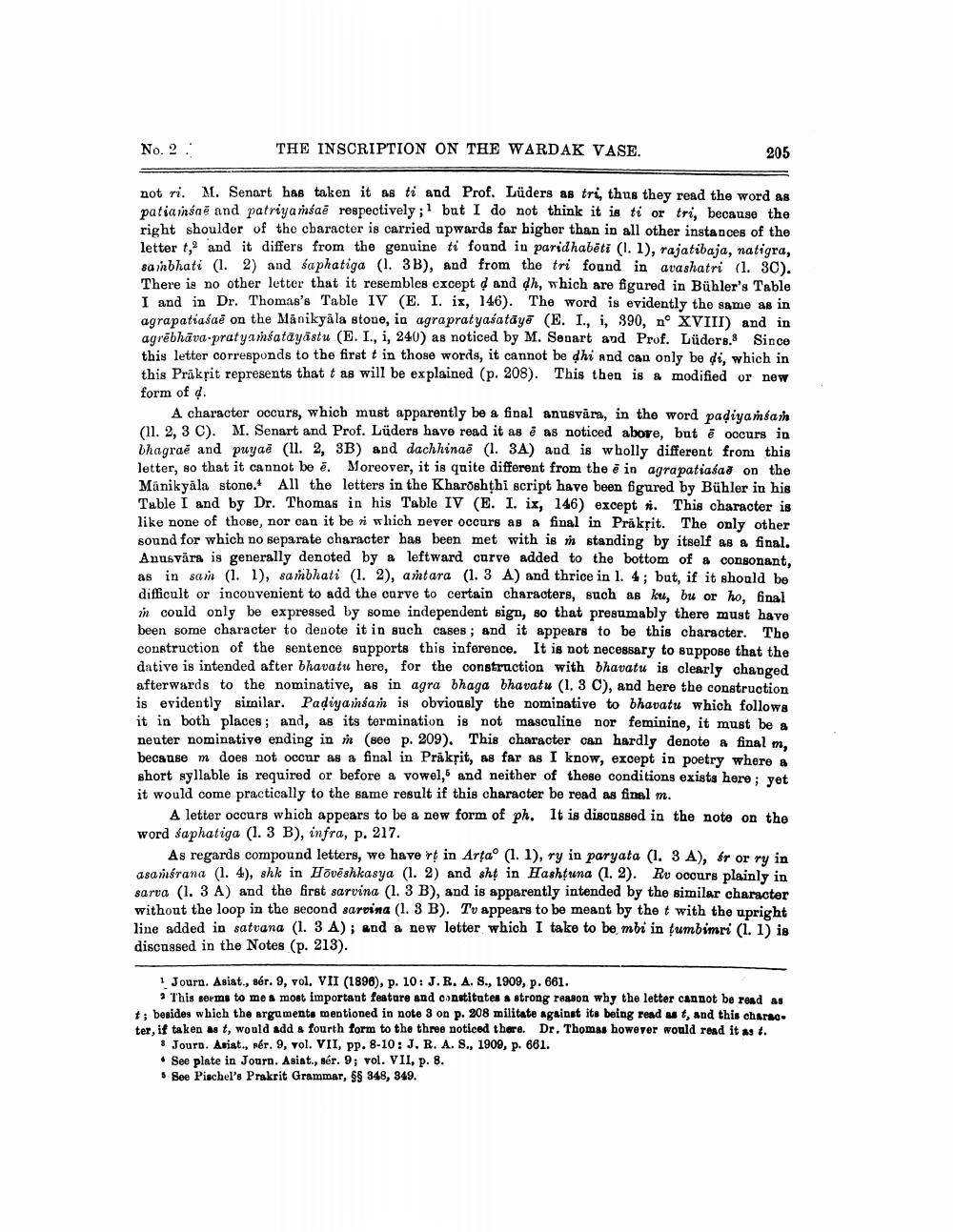________________
No. 2
THE INSCRIPTION ON THE WARDAK VASE.
205
not ri. M. Senart has taken it as ti and Prof. Lüders as tri, thus they read the word as patiainsač and patriyamsaē respectively; but I do not think it is ti or tri, because the right shoulder of the character is carried upwards for bigher than in all other instances of the letter t, and it differs from the genuine ti found in paridhabëti (1. 1), rajatibaja, natigra, sainbhati (1.2) and saphatiga (1. 3B), and from the tri found in avashatri (1. 30). There is no other letter that it resembles except d and dh, which are figured in Bühler's Table I and in Dr. Thomas's Table IV (E. I. ix, 146). The word is evidently the same as in agrapatia aê on the Mānikyåla stone, ia agrapratyasatāya (E. I., i, 390, no XVIII) and in agrēbhāva-pratyamsatayāstu (E. I., i, 240) as noticed by M. Senart and Prof. Lüders. Since this letter corresponds to the first t in those words, it cannot be dhi and can only be di, which in this Prūksit represents that t as will be explained (p. 208). This then is a modified or new form of .
A character occurs, which must apparently be a final anusvāra, in the word padiyamsan 01. 2. 3 C). M. Senart and Prof. Lüders have read it as ē as noticed above, but ő occurs in bhagrae and puyaē (ll. 2, 3B) and dachhinae (1.3A) and is wholly different from this letter, so that it cannot be ē. Moreover, it is quite different from the è in agrapatiasad on the Manikyāla stone. All the letters in the Kharoshthi script have been figured by Bühler in his Table I and by Dr. Thomas in his Table IV (E. I. ix, 146) except hi. This character is like none of those, nor can it be ni which never occurs as a final in Prākļit. The only other sound for which no separate character has been met with is standing by itself as a final. Anusvåra is generally denoted by a leftward carve added to the bottom of a consonant, as in sain (1.1), sambhati (1.2), antara (1. 3 A) and thrice in l. 4; but, if it should be difficult or inconvenient to add the curve to certain characters, such as ku, bu or ho, final in could only be expressed by some independent sign, so that presumably there must have been some character to denote it in such cases; and it appears to be this character. The construction of the sentence supports this inference. It is not necessary to suppose that the dative is intended after bhavatu here, for the construction with bhavatu is clearly changed afterwards to the nominative, as in agra bhaga bhavatu (1. 3 C), and here the construction is evidently similar. Padiya insan is obviously the nominative to bhavatu which follows it in both places; and, as its termination is not masculine nor feminine, it must be a neuter nominative ending in n (see p. 209). This character can hardly denote & final m, because m does not occur as a final in Prākļit, as far as I know, except in poetry where a short syllable is required or before a vowel, and neither of these conditions exists here; yet it would come practically to the same result if this character be read as final m.
A letter occurs which appears to be a new form of ph. It is discussed in the note on the word saphatiga (1. 3 B), infra, p. 217.
As regards compound letters, we have rt in Artao (1.1), ry in paryata (1. 3 A), fr or ry in asambrana (1. 4), shk in Hövēshkasya (1.2) and sht in Hashtuna (1. 2). Rv occurs plainly in sarva (1. 3 A) and the first sarvina (1. 3 B), and is apparently intended by the similar character without the loop in the second sarcina (1. 3 B). Tv appears to be meant by the t with the upright line added in satvana (1. 3 A); and a new letter which I take to be mbi in tumbimri (1.1) is discussed in the Notes (p. 213).
1 Journ. Asiat., sér. 9, vol. VII (1896), p. 10: J.R. A. S., 1909, p. 661.
This sorms to me a most important feature and constitutes a strong reason why the letter cannot be rend as t: besides which the argumento mentioned in note 3 on p. 208 militate against its being read w t, and this charao ter. It taken as t, would add a fourth form to the three noticed there. Dr. Thomas however would read it at.
• Journ. Aviat., pér. 9, vol. VII, pp. 8-10: J. R. A.S., 1909, p. 661. • See plate in Journ. Asiat., sér. 9; vol. VII, p. 8.
See Pischel's Prakrit Grammar, SS 348, 349.




